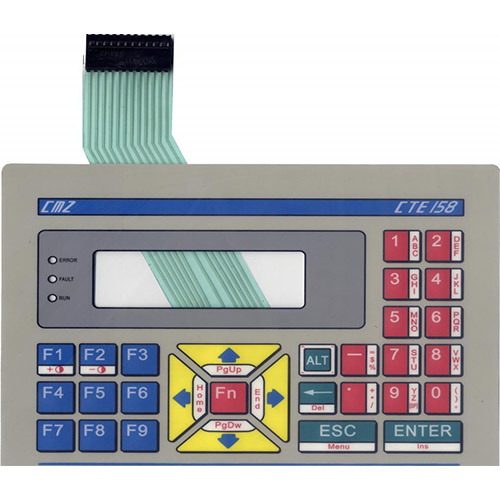
What are Membrane Switches?
Membrane switches are a type of human-machine interface made from layers of plastic films or other flexible materials. These films are printed or laminated with conductive materials and graphic inks. The switches work by temporarily opening or closing an electrical circuit when pressed. Their compact design and efficiency make them well-suited for a variety of applications, including in household appliances and industrial equipment.
What are the different types of membrane switches?
Membrane switches are a type of user interface commonly found in electronic devices and control panels. They are composed of multiple flexible layers: a top graphic overlay with printed symbols or labels, a spacer layer, and a bottom membrane layer featuring conductive traces. When a user presses a button on the graphic overlay, it bends and makes contact with the conductive traces on the bottom layer, completing an electrical circuit and registering the button press. Various types of membrane switches include:
Non-Tactile Membrane Switches
Non-tactile membrane switches lack physical feedback or a "click" sensation when pressed. They are typically used in applications where a gentle touch is preferred, providing a smoother user experience.
Tactile Membrane Switches
Tactile membrane switches are engineered to offer feedback to the user when pressed. They usually feature a dome or protrusion on the bottom membrane layer that collapses or clicks, providing a distinct tactile sensation and confirming the button press.
Metal Dome Membrane Switches
Metal dome membrane switches incorporate small metal domes as the tactile elements. When compressed, these domes deliver a distinct tactile sensation and audible feedback, making them ideal for applications where a clear, responsive button press is essential.
Polydome Membrane Switches
Polydome membrane switches utilize flexible plastic domes as the tactile elements. These polymer domes offer tactile feedback similar to metal dome switches, but at a lower cost, making them a more economical choice for many applications.
LED Backlit Membrane Switches
LED backlit membrane switches feature integrated Light Emitting Diodes (LEDs) beneath the graphic overlay to illuminate buttons or labels. This backlighting enhances visibility in low-light environments and is commonly employed in control panels and devices where clear, illuminated controls are essential.
Capacitive Membrane Switches
Capacitive membrane switches do not have physical moving parts like traditional membrane switches. Instead, they rely on changes in capacitance to detect when a user's finger approaches or touches a button. They are often used in applications where a touch-sensitive and sleek design is desired.
Sealed or Waterproof Membrane Switches
Sealed or waterproof membrane switches are engineered to resist moisture, dust, and other environmental factors. These switches are ideal for outdoor or industrial applications where protection from the elements is crucial.
Custom Membrane Switches
Custom membrane switches are designed to meet specific requirements, including the number of buttons, layout, graphic design, and tactile feedback. Manufacturers can tailor these switches to suit the unique needs of various applications.
Membrane Switch Construction
A typical membrane switch assembly typically consists of six to seven main layers:
1. Graphic Overlay – Graphic overlays are typically constructed of polyester, the material of choice due to its superior chemical resistance and flex life compared to polycarbonate. CSI can either digitally print, screen-print, or employ a combination of both methods to insure you get the right colors, textures, and finishes your Silver Flex membrane switch design requires.
2. Overlay Adhesive – The overlay adhesive layer bonds the graphic overlay to the top circuit layer. This overlay adhesive is typically an acrylic adhesive, selected for its durability and ability to maintain adherence in atypical environments, such as moist environments.
3. Top Circuit Layer – Typically a .005″ – .007″ heat-stabilized, polyester printed layer with silver-filled, electrically conductive inks and dielectric inks. This layer can also encapsulate metal domes or incorporate polydomes, which are used to achieve tactile feedback, an important design consideration impacting usability.
4. Circuit Spacer – This layer separates the top circuit from the bottom circuit, so the switch remains normally open until the keypad is pressed. The circuit spacer is a polyester spacer with adhesive on both sides.
5. Lower Circuit Layer – The lower circuit layer is typically a .005″ – .007″ heat-stabilized, polyester-printed layer with silver-filled electrically conductive inks and dielectric inks. This layer terminates as a flexible tail that serves as the interconnect to controller PCB’s or other electronics.
6. Rear Adhesive Layer – This adhesive layer bonds the entire membrane switch package to the product enclosure, housing, or to a rigid support panel. CSI can specify the appropriate adhesive type and thickness to bond your membrane keypad to your equipment.
7. Rigid Support Layer – This optional layer can add structural integrity to the membrane switch assembly. Materials can be aluminum, FR-4, steel, etc. Mounting hardware such as studs and standoffs can also be utilized in this layer.




 English
English
 中文
中文